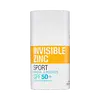What's inside
What's inside
 Key Ingredients
Key Ingredients

 Benefits
Benefits

 Concerns
Concerns

 Ingredients Side-by-side
Ingredients Side-by-side

Zinc Oxide 20%
Cosmetic ColorantEthylhexylglycerin
Skin ConditioningCoco-Caprylate/Caprate
EmollientButyloctyl Salicylate
Skin ConditioningPolyglyceryl-3 Methylglucose Distearate
EmulsifyingPolyglyceryl-3 Polyricinoleate
EmulsifyingHydroxypropyl Starch Phosphate
Hydroxyapatite
AbrasiveNiacinamide
SmoothingTocopheryl Acetate
AntioxidantIsostearic Acid
CleansingButyrospermum Parkii Butter
Skin ConditioningSodium Hyaluronate
HumectantSodium Stearoyl Glutamate
CleansingHydroxyacetophenone
AntioxidantMagnesium Aluminum Silicate
AbsorbentHydroxyethylcellulose
Emulsion StabilisingPEG-100 Stearate
Glycine Soja Oil
EmollientEthyl Linoleate
EmollientHydrolyzed Soy Protein
HumectantAscorbyl Tetraisopalmitate
AntioxidantRice Amino Acids
Skin ConditioningPolyglyceryl-3 Diisostearate
EmulsifyingSodium Hydroxide
BufferingOryza Sativa Extract
AbsorbentProline
Skin ConditioningHydrolyzed Adansonia Digitata Seed Extract
Oryza Sativa Germ Extract
EmollientCI 77492
Cosmetic ColorantCI 77491
Cosmetic ColorantCI 77499
Cosmetic ColorantZinc Oxide 20%, Ethylhexylglycerin, Coco-Caprylate/Caprate, Butyloctyl Salicylate, Polyglyceryl-3 Methylglucose Distearate, Polyglyceryl-3 Polyricinoleate, Hydroxypropyl Starch Phosphate, Hydroxyapatite, Niacinamide, Tocopheryl Acetate, Isostearic Acid, Butyrospermum Parkii Butter, Sodium Hyaluronate, Sodium Stearoyl Glutamate, Hydroxyacetophenone, Magnesium Aluminum Silicate, Hydroxyethylcellulose, PEG-100 Stearate, Glycine Soja Oil, Ethyl Linoleate, Hydrolyzed Soy Protein, Ascorbyl Tetraisopalmitate, Rice Amino Acids, Polyglyceryl-3 Diisostearate, Sodium Hydroxide, Oryza Sativa Extract, Proline, Hydrolyzed Adansonia Digitata Seed Extract, Oryza Sativa Germ Extract, CI 77492, CI 77491, CI 77499
Zinc Oxide 27%
Cosmetic ColorantWater
Skin ConditioningGlycerin
HumectantCetearyl Alcohol
EmollientCetearyl Glucoside
EmulsifyingCyclopentasiloxane
EmollientDimethicone
EmollientGlyceryl Isostearate
EmollientPolyglyceryl-4 Isostearate
EmulsifyingHexyl Laurate
EmollientCetyl PEG/PPG-10/1 Dimethicone
EmulsifyingHydroxyethyl Acrylate/Sodium Acryloyldimethyl Taurate Copolymer
Emulsion StabilisingSodium Hydroxide
BufferingEthylhexylglycerin
Skin ConditioningPhenoxyethanol
PreservativeTriethoxycaprylylsilane
Zinc Oxide 27%, Water, Glycerin, Cetearyl Alcohol, Cetearyl Glucoside, Cyclopentasiloxane, Dimethicone, Glyceryl Isostearate, Polyglyceryl-4 Isostearate, Hexyl Laurate, Cetyl PEG/PPG-10/1 Dimethicone, Hydroxyethyl Acrylate/Sodium Acryloyldimethyl Taurate Copolymer, Sodium Hydroxide, Ethylhexylglycerin, Phenoxyethanol, Triethoxycaprylylsilane
Ingredients Explained
These ingredients are found in both products.
Ingredients higher up in an ingredient list are typically present in a larger amount.
Ethylhexylglycerin (we can't pronounce this either) is commonly used as a preservative and skin softener. It is derived from glyceryl.
You might see Ethylhexylglycerin often paired with other preservatives such as phenoxyethanol. Ethylhexylglycerin has been found to increase the effectiveness of these other preservatives.
Sodium Hydroxide is also known as lye or caustic soda. It is used to adjust the pH of products; many ingredients require a specific pH to be effective.
In small amounts, sodium hydroxide is considered safe to use. However, large amounts may cause chemical burns due to its high alkaline.
Your skin has a natural pH and acid mantle. This acid mantle helps prevent harmful bacteria from breaking through. The acid mantle also helps keep your skin hydrated.
"Alkaline" refers to a high pH level. A low pH level would be considered acidic.
Learn more about Sodium HydroxideZinc Oxide is a mineral broad-spectrum UV filter; it is the broadest UVA and UVB reflector approved by the FDA. It also has skin protectant and skin soothing properties.
Zinc oxide is one of the most effective broad-spectrum UV filters. It protects against UVB, UVAII, and UVAI. In comparison to its counterpart titanium dioxide, zinc oxide provides uniform and extended UVA protection.
Another great benefit? This ingredient is highly photostable so it won't degrade easily under sunlight.
A common myth is that mineral UV filters are widely believed to primarily reflect UV light.
However, modern research shows titanium dioxide absorbs UV radiation like chemical filters (~95% absorption & 5% reflection).
Zinc oxide has great skin soothing properties so you'll likely find this in sunscreens formulated for sensitive skin or babies/children. It is unlikely to cause "eye sting" like other sunscreen ingredients.
Regulatory agencies consider zinc oxide to be non-toxic and safe. It has also been shown to not penetrate the skin.
Unfortunately, this ingredient does leave a visible white cast. This is why mineral sunscreens are often less cosmetically elegant than chemical or hybrid ones.
In cosmetics, zinc oxide can be found in both non-nano and nano-sized forms. The nano version is used to reduce white cast and improve the texture of sunscreen formulas.
There are ongoing concerns surrounding nano-zinc oxide's impact on marine ecosystems and whether it can be absorbed into skin.
Regarding marine ecosystems and coral reefs, there is no conclusive evidence that any form of zinc oxide (or any other sunscreen ingredients) will cause harm. The science is still developing but many consumers are keeping a close eye on this issue.
Please note, many destinations have reef-safety sunscreen rules. For instance, the U.S. Virgin Islands advises all visitors to use non-nano mineral sunscreens.
There has also been some stir about whether micronized or nano zinc oxide has potential photoxicity and absorption through the skin/lungs.
An in-vitro (done in a test tube or petri dish) study demonstrated micronized zinc oxide to have potential phototoxicity. There's no need to fret; the EU Commission's Scientific Committee on Consumer Safety has stated, "The relevance of these findings needs to be clarified by appropriate investigations in vivo." Or in other words, further studies done on living organisms are needed to prove this.
Current research shows zinc oxide nanoparticles do not penetrate intact or sunburned skin. They either remain on the surface or in the outermost layer of dead skin (stratum corneum).
Zinc oxide is one of only two classified mineral UV filters with titanium dioxide being the other one.
Fun fact: Zinc has been used throughout history as an ingredient in paint and medicine. An Indian text from 500BC is believed to list zinc oxide as a salve for open wound. The Ancient Greek physician Dioscorides has also mentioned the use of zinc as an ointment in 1AD.
Learn more about Zinc Oxide